Analysis of Large-Scale Environmental Features during Maximum Intensity of Tropical Cyclones Using Reanalysis Data
Abstract
1. Introduction
2. Materials and Methods
2.1. TC Tracks Data
2.2. ERA5 Reanalysis Data
2.3. Clustering Technique
2.4. Composite Analysis
2.5. OLR Dipole Characteristics
3. Results and Discussion
3.1. Composites of Divergence and Wind Fields
3.2. Composites of Relative Humidity
3.3. Radial-Height Distribution of Divergence, Streamline Fields, and Wind Shear
3.4. Composites of Outgoing Longwave Radiation
4. Summary and Conclusions
Supplementary Materials
Author Contributions
Funding
Institutional Review Board Statement
Informed Consent Statement
Data Availability Statement
Acknowledgments
Conflicts of Interest
References
- Gray, W.M. The formation of tropical cyclones. Meteor. Atmos. Phys. 1998, 67, 37–69. [Google Scholar] [CrossRef]
- Bhaskaran, P.K.; Rao, A.D.; Murty, T. Tropical cyclone-induced storm surges and wind waves in the Bay of Bengal. In Techniques for Disaster Risk Management and Mitigation, 1st ed.; Srivastava, P.K., Singh, S.K., Mohanty, U.C., Murty, T., Eds.; Wiley: New York, NY, USA, 2020; pp. 239–294. [Google Scholar]
- Kunze, S. Unraveling the effects of tropical cyclones on economic sectors worldwide: Direct and indirect impacts. Environ. Resour. Econ. 2021, 78, 545–569. [Google Scholar] [CrossRef]
- Yamada, H.; Moteki, Q.; Yoshizaki, M. The unusual track and rapid intensification of Cyclone Nargis in 2008 under a characteristic environmental flow over the Bay of Bengal. J. Meteorol. Soc. Jpn. Ser. II 2010, 88, 437–453. [Google Scholar] [CrossRef]
- Vissa, N.K.; Satyanarayana, A.N.V.; Bhaskaran, P.K. The intensity of tropical cyclones during pre- and post-monsoon seasons in relation to accumulated tropical cyclone heat potential over Bay of Bengal. Nat. Hazards 2013, 68, 351–371. [Google Scholar] [CrossRef]
- Balaguru, K.; Taraphdar, S.; Leung, L.R.; Foltz, G.R. Increase in the intensity of postmonsoon Bay of Bengal tropical cyclones. Geophys. Res. Lett. 2014, 41, 3594–3601. [Google Scholar] [CrossRef]
- Srinivas, C.V.; Mohan, G.M.; Naidu, C.V.; Baskaran, R.; Venkatraman, B. Impact of air-sea coupling on the simulation of tropical cyclones in the North Indian Ocean using a simple 3-D ocean model coupled to ARW. J. Geophys. Res. Atmos. 2016, 121, 9400–9421. [Google Scholar] [CrossRef]
- Vissa, N.K.; Satyanarayana, A.N.V.; Bhaskaran, P.K. Response of oceanic cyclogenesis metrics for NARGIS cyclone: A case study. Atmos. Sci. Lett. 2013, 14, 7–13. [Google Scholar] [CrossRef]
- Singh, K.; Panda, J.; Sahoo, M.; Mohapatra, M. Variability in tropical cyclone climatology over North Indian Ocean during the period 1891 to 2015. Asia-Pac. J. Atmos. Sci. 2019, 55, 269–287. [Google Scholar] [CrossRef]
- Akter, N.; Tsuboki, K. Recurvature and movement processes of tropical cyclones over the Bay of Bengal. Q. J. R. Meteorol. Soc. 2021, 147, 3681–3702. [Google Scholar] [CrossRef]
- Smith, M.; Toumi, R. A dipole of tropical cyclone outgoing long-wave radiation. Q. J. R. Meteorol. Soc. 2021, 147, 166–180. [Google Scholar] [CrossRef]
- Prakash, K.R.; Pant, V.; Udaya Bhaskar, T.V.S.; Chandra, N. What Made the Sustained Intensification of Tropical Cyclone Fani in the Bay of Bengal? An Investigation Using Coupled Atmosphere-Ocean Model. Atmosphere 2022, 13, 535. [Google Scholar] [CrossRef]
- Singh, V.K.; Roxy, M.K. A review of ocean-atmosphere interactions during tropical cyclones in the north Indian Ocean. Earth-Sci. Rev. 2022, 226, 103967. [Google Scholar] [CrossRef]
- Hill, K.A.; Lackmann, G.M. Influence of environmental humidity on tropical cyclone size. Mon. Weather Rev. 2009, 137, 3294–3315. [Google Scholar] [CrossRef]
- Gopalakrishnan, S.G.; Osuri, K.K.; Marks, F.D.; Mohanty, U.C. An inner-core analysis of the axisymmetric and asymmetric intensification of tropical cyclones: Influence of shear. Mausam 2019, 70, 667–690. [Google Scholar] [CrossRef]
- Kumar, S.; Panda, J.; Paul, D.; Guha, B.K. Impact of environmental variables on the North Indian Ocean tropical cyclones radial parameters. Clim. Dyn. 2022, 1–18. [Google Scholar] [CrossRef]
- Nekkali, Y.S.; Osuri, K.K.; Das, A.K.; Niyogi, D. Understanding the characteristics of microphysical processes in the rapid intensity changes of tropical cyclones over the Bay of Bengal. Q. J. R. Meteorol. Soc. 2022, 148, 3715–3729. [Google Scholar] [CrossRef]
- Holland, G.J. Tropical cyclone motion: Environmental interaction plus a beta effect. J. Atmos. Sci. 1983, 40, 328–342. [Google Scholar] [CrossRef]
- Chan, K.T.; Chan, J.C. Tropical cyclone recurvature: An intrinsic property? Geophys. Res. Lett. 2016, 43, 8769–8774. [Google Scholar] [CrossRef]
- Albert, J.; Bhaskaran, P.K. Ocean heat content and its role in tropical cyclogenesis for the Bay of Bengal basin. Clim. Dyn. 2020, 55, 3343–3362. [Google Scholar] [CrossRef]
- Yesubabu, V.; Kattamanchi, V.K.; Vissa, N.K.; Dasari, H.P.; Sarangam, V.B.R. Impact of ocean mixed-layer depth initialization on the simulation of tropical cyclones over the Bay of Bengal using the WRF-ARW model. Meteorol. Appl. 2020, 27, e1862. [Google Scholar] [CrossRef]
- Nellipudi, N.R.; Viswanadhapalli, Y.; Challa, V.S.; Vissa, N.K.; Langodan, S. Impact of surface roughness parameterizations on tropical cyclone simulations over the Bay of Bengal using WRF-OML model. Atmos. Res. 2021, 262, 105779. [Google Scholar] [CrossRef]
- Vissa, N.K.; Anandh, P.C.; Gulakaram, V.S.; Konda, G. Role and response of ocean–atmosphere interactions during Amphan (2020) super cyclone. Acta Geophys. 2021, 69, 1997–2010. [Google Scholar] [CrossRef]
- Paul, D.; Panda, J.; Routray, A. Ocean and atmospheric characteristics associated with the cyclogenesis and rapid intensification of NIO super cyclonic storms during 1981–2020. Nat. Hazards 2022, 114, 261–289. [Google Scholar] [CrossRef]
- Geetha, B.; Balachandran, S. Diabatic Heating and Convective Asymmetries During Rapid Intensity Changes of Tropical Cyclones Over North Indian Ocean. Trop. Cyclone Res. Rev. 2016, 5, 32–46. [Google Scholar]
- Bhalachandran, S.; Haddad, Z.S.; Hristova-Veleva, S.M.; Marks, F.D., Jr. The relative importance of factors influencing tropical cyclone rapid intensity changes. Geophys. Res. Lett. 2019, 46, 2282–2292. [Google Scholar] [CrossRef]
- Francis, D.; Fonseca, R.; Nelli, N. Key Factors Modulating the Threat of the Arabian Sea’s Tropical Cyclones to the Gulf Countries. J. Geophys. Res. Atmos. 2022, 127, e2022JD036528. [Google Scholar] [CrossRef]
- Singh, V.K.; Roxy, M.K.; Deshpande, M. Role of subtropical Rossby waves in governing the track of cyclones in the Bay of Bengal. Q. J. R. Meteorol. Soc. 2022, 148, 3774–3787. [Google Scholar] [CrossRef]
- Lee, C.S.; Edson, R.; Gray, W.M. Some large-scale characteristics associated with tropical cyclone development in the North Indian Ocean during FGGE. Mon. Weather Rev. 1989, 117, 407–426. [Google Scholar] [CrossRef]
- Ventham, J.D.; Wang, B. Large-scale flow patterns and their influence on the intensification rates of western North Pacific tropical storms. Mon. Weather Rev. 2007, 135, 1110–1127. [Google Scholar] [CrossRef]
- Wu, L.; Su, H.; Fovell, R.G.; Wang, B.; Shen, J.T.; Kahn, B.H.; Hristova-Veleva, S.M.; Lambrigtsen, B.H.; Fetzer, E.J.; Jiang, J.H. Relationship of environmental relative humidity with North Atlantic tropical cyclone intensity and intensification rate. Geophys. Res. Lett. 2012, 39, L2080. [Google Scholar] [CrossRef]
- Wu, L.; Su, H.; Fovell, R.G.; Dunkerton, T.J.; Wang, Z.; Kahn, B.H. Impact of environmental moisture on tropical cyclone intensification. Atmos. Chem. Phys. 2015, 15, 14041–14053. [Google Scholar] [CrossRef]
- Ge, X.; Li, T.; Peng, M. Effects of vertical shears and midlevel dry air on tropical cyclone developments. J. Atmos. Sci. 2013, 70, 3859–3875. [Google Scholar] [CrossRef]
- Chan, J.C.L. The physics of tropical cyclone motion. Annu. Rev. Fluid Mech. 2005, 37, 99–128. [Google Scholar] [CrossRef]
- Sanap, S.D.; Mohapatra, M.; Ali, M.M.; Priya, P.; Varaprasad, D. On the dynamics of cyclogenesis, rapid intensification and recurvature of the very severe cyclonic storm, Ockhi. J. Earth Syst. Sci. 2020, 129, 194. [Google Scholar] [CrossRef]
- Pal, A.; Chatterjee, S. The influence of upper level surrounding winds on tropical cyclone motion: A case study of the Bay of Bengal region. Proc. Natl. Acad. Sci. USA 2021, 87, 343–350. [Google Scholar] [CrossRef]
- Chan, J.C.; Gray, W.M. Tropical cyclone movement and surrounding flow relationships. Mon. Weather Rev. 1982, 110, 1354–1374. [Google Scholar] [CrossRef]
- Schenkel, B.A.; Hart, R.E. An examination of tropical cyclone position, intensity, and intensity life cycle within atmospheric reanalysis datasets. J. Clim. 2012, 25, 3453–3475. [Google Scholar] [CrossRef]
- Ditchek, S.D.; Nelsona, T.C.; Rosenmayer, M.; Corbosiero, K.L. The relationship between tropical cyclones at genesis and their maximum attained intensity. J. Clim. 2017, 30, 4897–4913. [Google Scholar] [CrossRef]
- Lu, R.; Tang, X. Relationship between Early-Stage Features and Lifetime Maximum Intensity of Tropical Cyclones over the Western North Pacific. Atmosphere 2021, 12, 815. [Google Scholar] [CrossRef]
- Singh, O.P.; Khan, T.A.; Rahman, M.S. Changes in the frequency of tropical cyclones over the North Indian Ocean. Meteorol. Atmos. Phys. 2000, 75, 11–20. [Google Scholar] [CrossRef]
- Singh, O.P.; Khan, T.M.A.; Rahman, M.S. Has the frequency of intense tropical cyclones increased in the north Indian Ocean? Curr. Sci. 2001, 80, 575–580. [Google Scholar]
- Ramsay, H. The Global Climatology of Tropical Cyclones. Oxf. Res. Encycl. Nat. Hazard Sci. 2017. [Google Scholar]
- Li, Z.; Yu, W.; Li, T.; Murty, V.S.N.; Tangang, F. Bimodal character of cyclone climatology in Bay of Bengal modulated by monsoon seasonal cycle. J. Clim. 2013, 26, 1033–1046. [Google Scholar] [CrossRef]
- Dube, S.K.; Rao, A.D.; Poulose, J.; Mohapatra, M.; Murty, T.S. Storm surge inundation in South Asia under climate change scenarios. In Monitoring and Prediction of Tropical Cyclones in the Indian Ocean and Climate Change; Mohanty, U.C., Mohapatra, M., Singh, O.P., Bandyopadhyay, B.K., Rathore, L.S., Eds.; Springer: Dordrecht, The Netherlands, 2014; pp. 355–363. [Google Scholar]
- Sahoo, B.; Bhaskaran, P.K. Assessment on historical cyclone tracks in the Bay of Bengal, east coast of India. Int. J. Clim. 2016, 36, 95–109. [Google Scholar] [CrossRef]
- Kabir, R.; Ritchie, E.A.; Stark, C. Tropical Cyclone Exposure in the North Indian Ocean. Atmosphere 2022, 13, 1421. [Google Scholar] [CrossRef]
- Vinodhkumar, B.; Busireddy, N.K.R.; Ankur, K.; Nadimpalli, R.; Osuri, K.K. On occurrence of rapid intensification and rainfall changes in tropical cyclones over the North Indian Ocean. Int. J. Clim. 2022, 42, 714–726. [Google Scholar] [CrossRef]
- Mohapatra, M.; Nayak, D.P.; Sharma, R.P.; Bandyopadhyay, B.K. Evaluation of official tropical cyclone track forecast over north Indian Ocean issued by India Meteorological Department. J. Earth Syst. Sci. 2013, 122, 589–601. [Google Scholar] [CrossRef]
- Murakami, H. Tropical cyclones in reanalysis data sets. Geophys. Res. Lett. 2014, 41, 2133–2141. [Google Scholar] [CrossRef]
- Malakar, P.; Kesarkar, A.P.; Bhate, J.N.; Singh, V.; Deshamukhya, A. Comparison of Reanalysis Data Sets to Comprehend the Evolution of Tropical Cyclones Over North Indian Ocean. Earth Space Sci. 2020, 7, e2019EA000978. [Google Scholar] [CrossRef]
- Priya, P.; Pattnaik, S.; Trivedi, D. Characteristics of the tropical cyclones over the North Indian Ocean Basins from the long-term datasets. Meteorol. Atmos. Phys. 2022, 134, 65. [Google Scholar] [CrossRef]
- Hersbach, H.; Bell, B.; Berrisford, P.; Hirahara, S.; Horányi, A.; Muñoz-Sabater, J.; Nicolas, J.; Peubey, C.; Radu, R.; Schepers, D.; et al. The ERA5 global reanalysis. Q. J. R. Meteorol. Soc. 2020, 146, 1999–2049. [Google Scholar] [CrossRef]
- Fahim, A.M.; Salem, A.M.; Torkey, F.A.; Ramadan, M. An efficient enhanced k-means clustering algorithm. J. Zhejiang Univ.-Sci. A 2006, 7, 1626–1633. [Google Scholar] [CrossRef]
- Na, S.; Xumin, L.; Yong, G. Research on k-means Clustering Algorithm: An Improved k-means Clustering Algoritm. In Proceedings of the 2010 Third International Symposium on Intelligent Information Technology and Security Informatics, Jinggangshan, China, 2–4 April 2010; pp. 63–67. [Google Scholar]
- Elsner, J.B. Tracking hurricanes. Bull. Am. Meteorol. Soc. 2003, 84, 353–356. [Google Scholar] [CrossRef]
- Kossin, J.P.; Camargo, S.J.; Sitkowski, M. Climate modulation of North Atlantic hurricane tracks. J. Clim. 2010, 23, 3057–3076. [Google Scholar] [CrossRef]
- Li, W.W.; Wang, C.; Wang, D.; Yang, L.; Deng, Y. Modulation of low-latitude west wind on abnormal track and intensity of tropical cyclone Nargis (2008) in the Bay of Bengal. Adv. Atmos. Sci. 2012, 29, 407–421. [Google Scholar] [CrossRef]
- Ying, Y.; Zhang, Q. A modeling study on tropical cyclone structural changes in response to ambient moisture variations. J. Meteorol. Soc. Jpn. Ser. II 2012, 90, 755–770. [Google Scholar] [CrossRef]
- Wang, S.; Toumi, R. Impact of dry midlevel air on the tropical cyclone outer circulation. J. Atmos. Sci. 2019, 76, 1809–1826. [Google Scholar] [CrossRef]
- Chen, Y.; Gao, S.; Li, X.; Shen, X. Key environmental factors for rapid intensification of the South China Sea tropical cyclones. Front. Earth Sci. 2021, 8, 609727. [Google Scholar] [CrossRef]
- Wang, Y.; Rao, Y.; Tan, Z.M.; Schönemann, D.A. statistical analysis of the effects of vertical wind shear on tropical cyclone intensity change over the western North Pacific. Mon. Weather Rev. 2015, 143, 3434–3453. [Google Scholar] [CrossRef]
- Wu, L.; Wang, C.; Wang, B. Westward shift of western North Pacific tropical cyclogenesis. Geophys. Res. Lett. 2015, 42, 1537–1542. [Google Scholar] [CrossRef]
- Tang, B.; Emanuel, K. Sensitivity of tropical cyclone intensity to ventilation in an axisymmetric model. J. Atmos. Sci. 2012, 69, 2394–2413. [Google Scholar] [CrossRef]
- Alland, J.J.; Tang, B.H.; Corbosiero, K.L.; Bryan, G.H. Combined effects of midlevel dry air and vertical wind shear on tropical cyclone development. Part I: Downdraft ventilation. J. Atmos. Sci. 2021, 78, 763–782. [Google Scholar] [CrossRef]
- Alland, J.J.; Tang, B.H.; Corbosiero, K.L.; Bryan, G.H. Combined effects of midlevel dry air and vertical wind shear on tropical cyclone development. Part II: Radial ventilation. J. Atmos. Sci. 2021, 78, 783–796. [Google Scholar] [CrossRef]
- Rafiq, L.; Blaschke, T.; Tajbar, S. Arabian Sea cyclone: Structure analysis using satellite data. Adv. Space Res. 2015, 56, 2235–2247. [Google Scholar] [CrossRef]
- Karnauskas, K.B.; Li, L. Predicting Atlantic seasonal hurricane activity using outgoing longwave radiation over Africa. Geophys. Res. Lett. 2016, 43, 7152–7159. [Google Scholar] [CrossRef]
- Subrahmanyam, B.; Murty, V.S.N.; Sharp, R.; O’Brien, J. Air-sea coupling during the tropical cyclones in the Indian Ocean: A case study using satellite observations. Pure Appl. Geophys. 2005, 162, 1643–1672. [Google Scholar] [CrossRef]
- Yesubabu, V.; Challa, V.; Srinivas, V.; Basha, G.; Dasari, H.P.; Langodan, S.; Ratnam, M.V.; Hoteit, I. A diagnostic study of extreme precipitation over Kerala during August 2018. Atmos. Sci. Lett. 2019, 20, e941. [Google Scholar]
- Chen, Y.; Sharma, S.; Zhou, X.; Yang, K.; Li, X.; Niu, X.; Hu, X.; Khadka, N. Spatial performance of multiple reanalysis precipitation datasets on the southern slope of central Himalaya. Atmos. Res. 2021, 250, 105365. [Google Scholar] [CrossRef]
- Prathipati, V.K.; Yesubabu, V.; Chennu, C.N.; Dasari, H.P. Study of Active and Break Spell Phenomena of Indian Summer Monsoon Using WRF Downscaled Data. Pure Appl. Geophys. 2021, 178, 4195–4219. [Google Scholar] [CrossRef]
- Dasari, H.P.; Viswanadhapalli, Y.; Langodan, S.; Abualnaja, Y.; Desamsetti, S.; Vankayalapati, K.; Thang, L.; Hoteit, I. High-resolution climate characteristics of the Arabian Gulf based on a validated regional reanalysis. Meteorol. Appl. 2022, 29, e2102. [Google Scholar] [CrossRef]
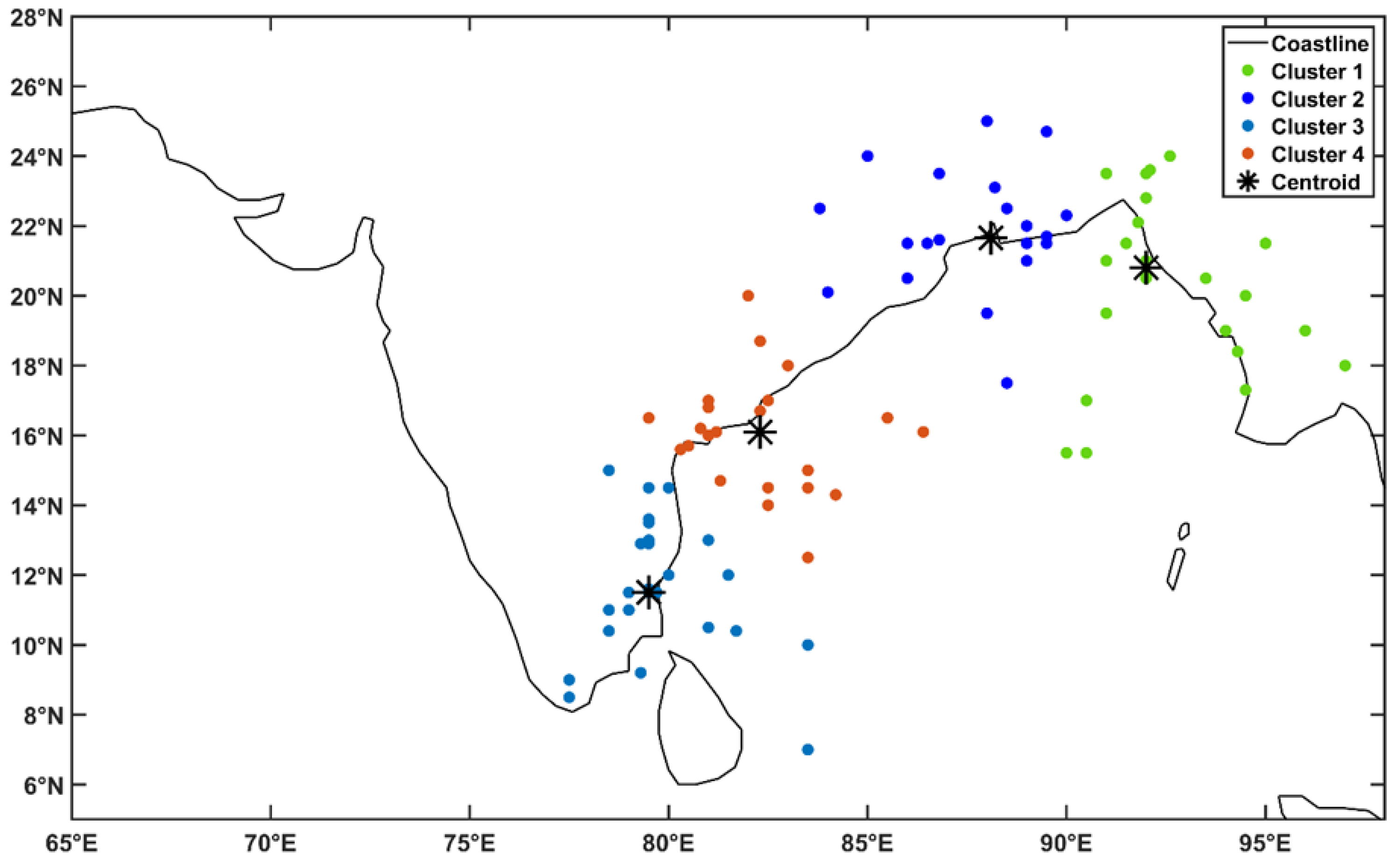

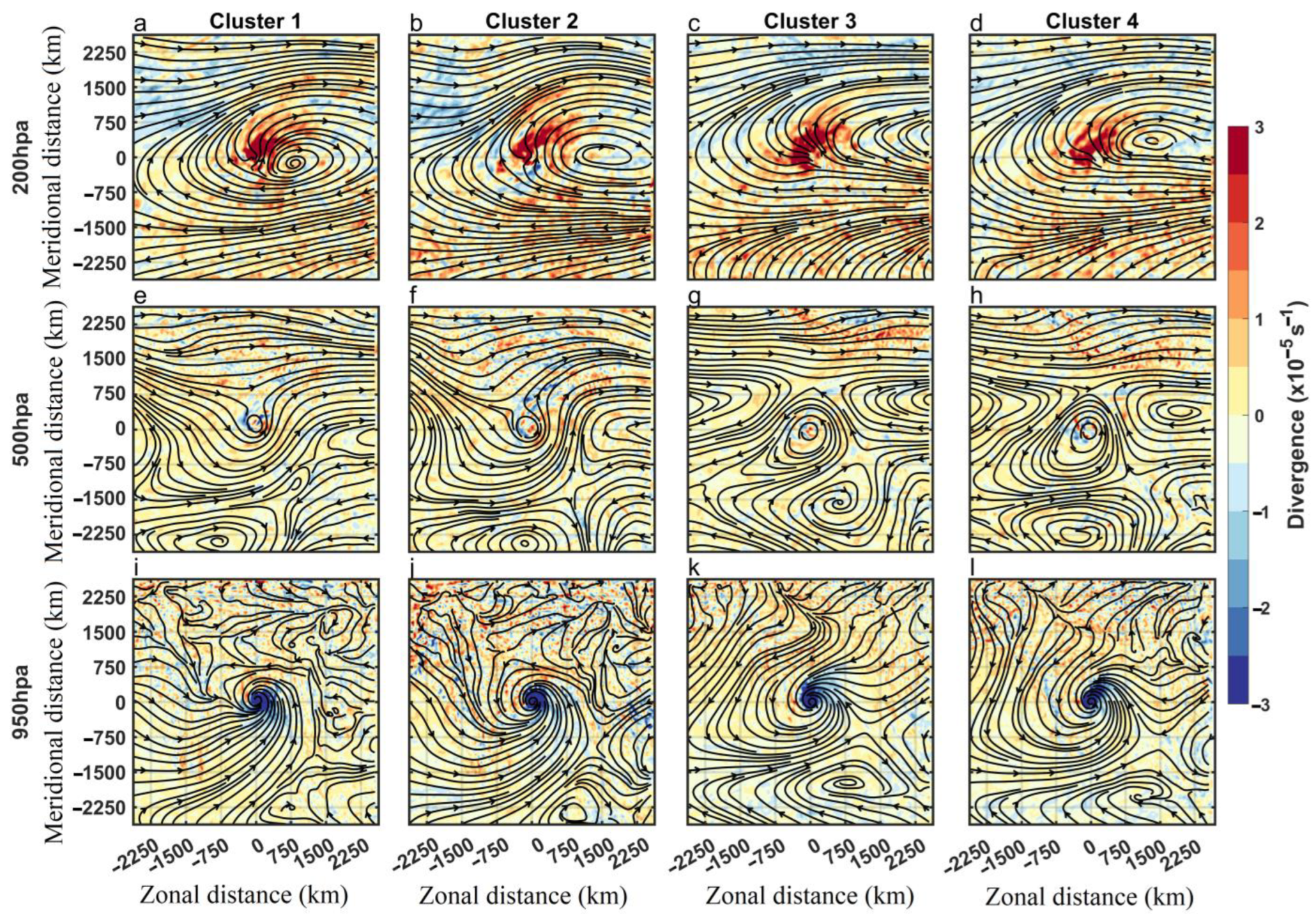
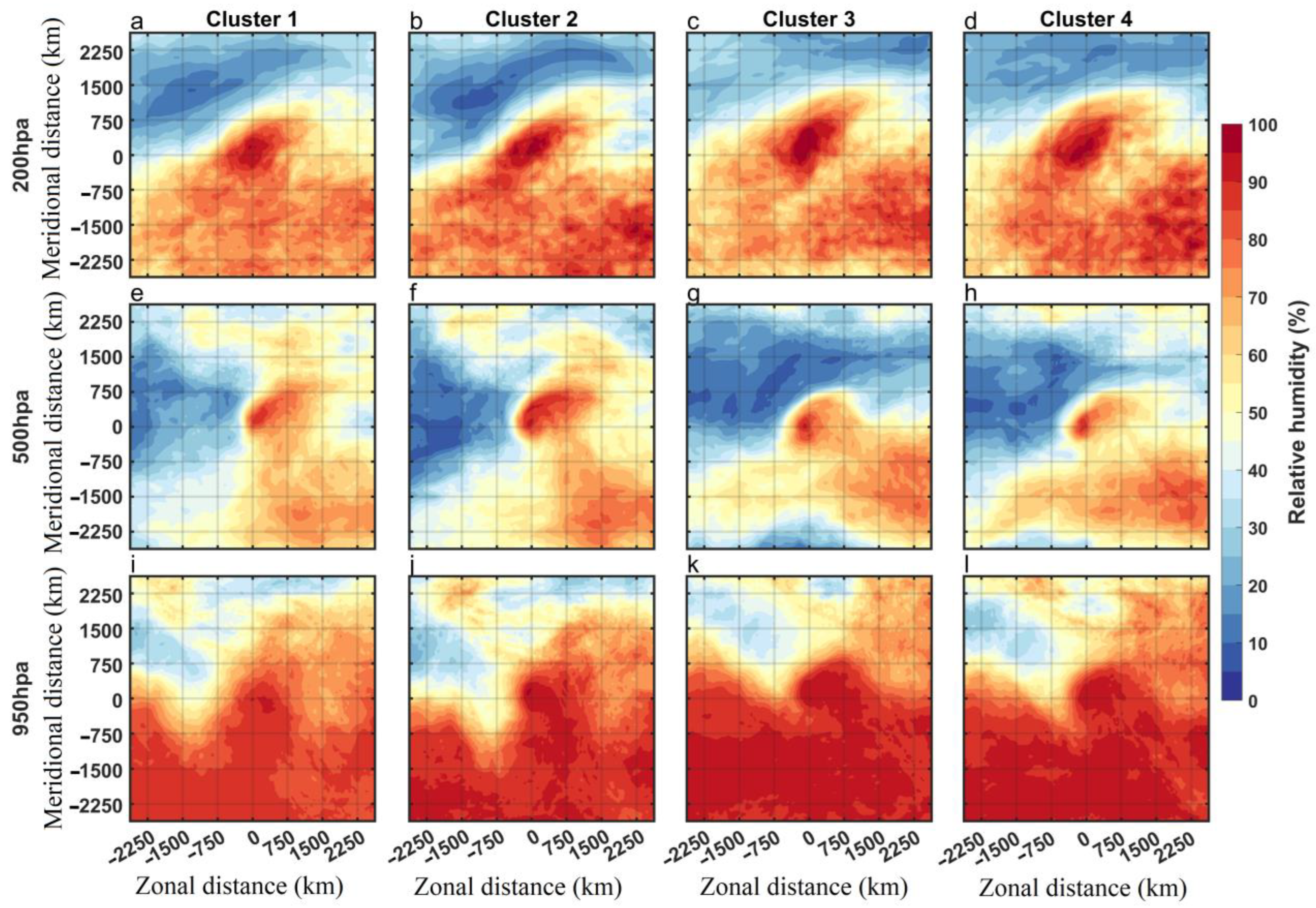
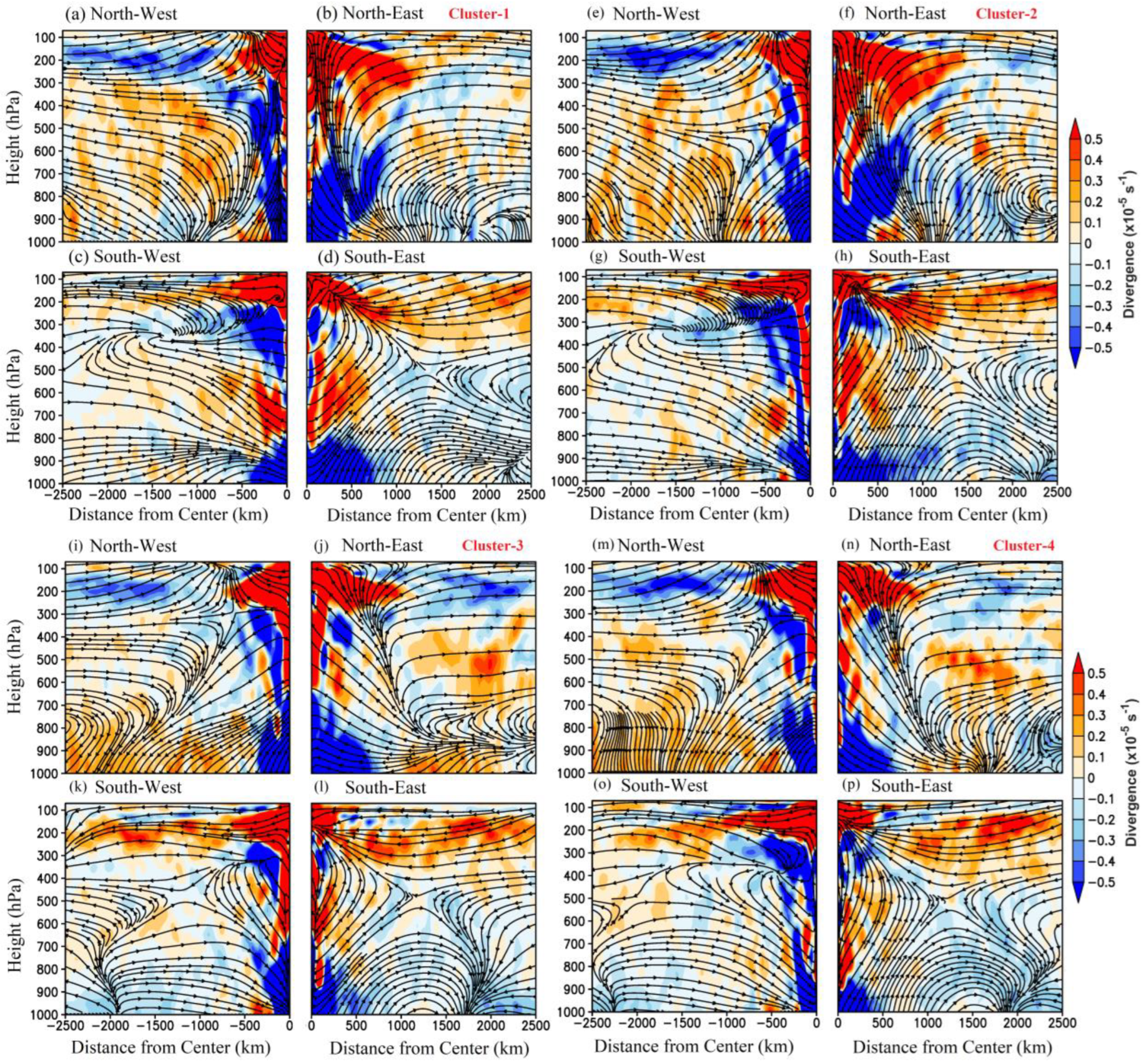

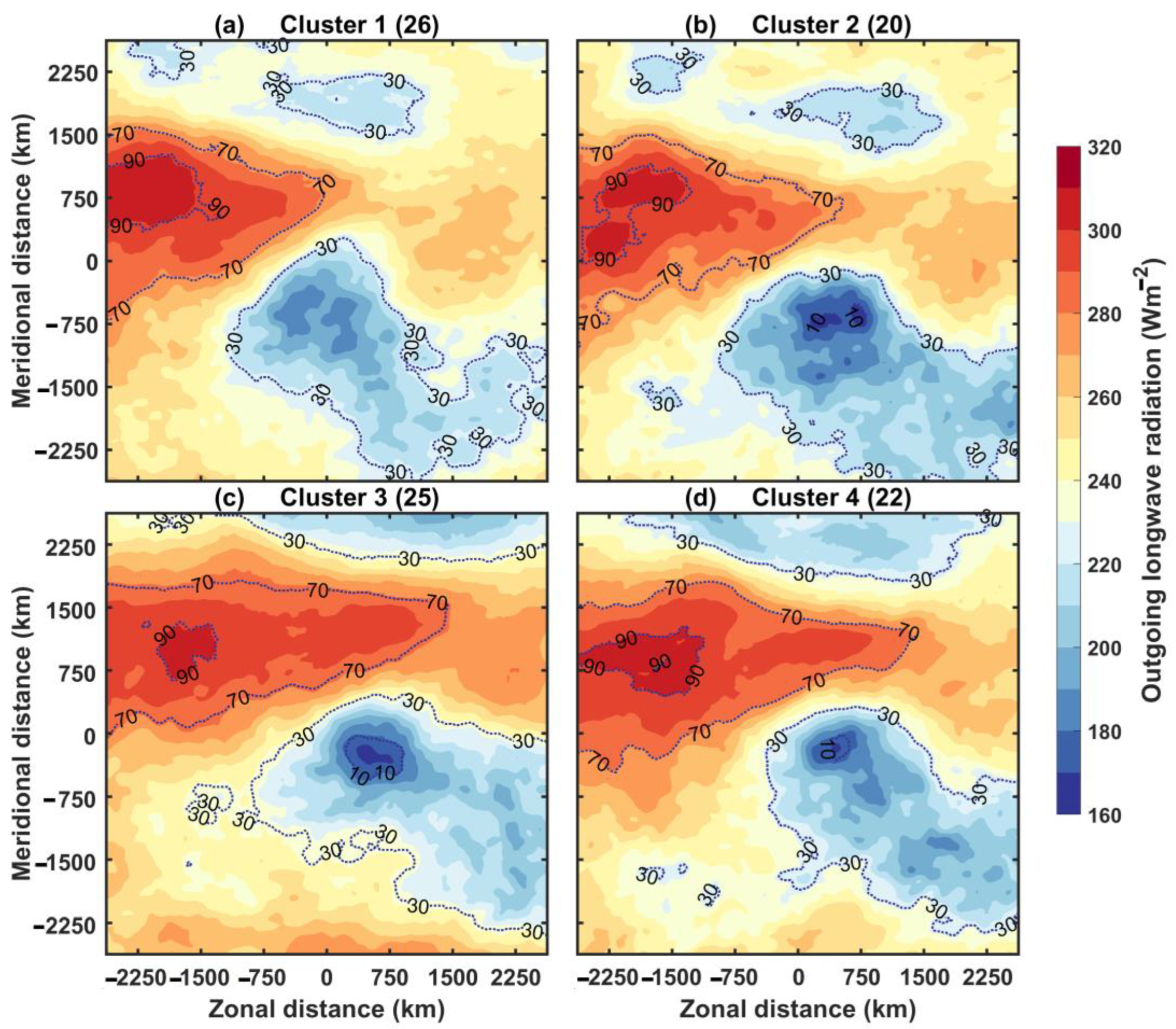
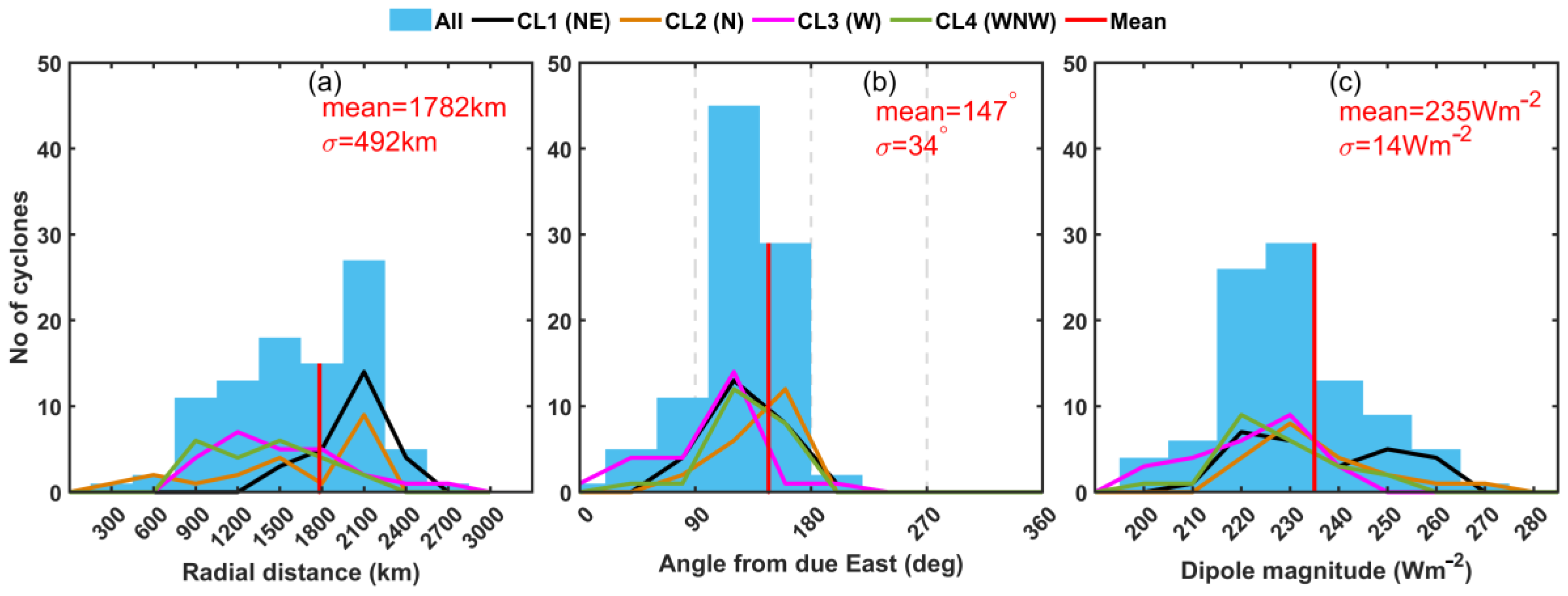
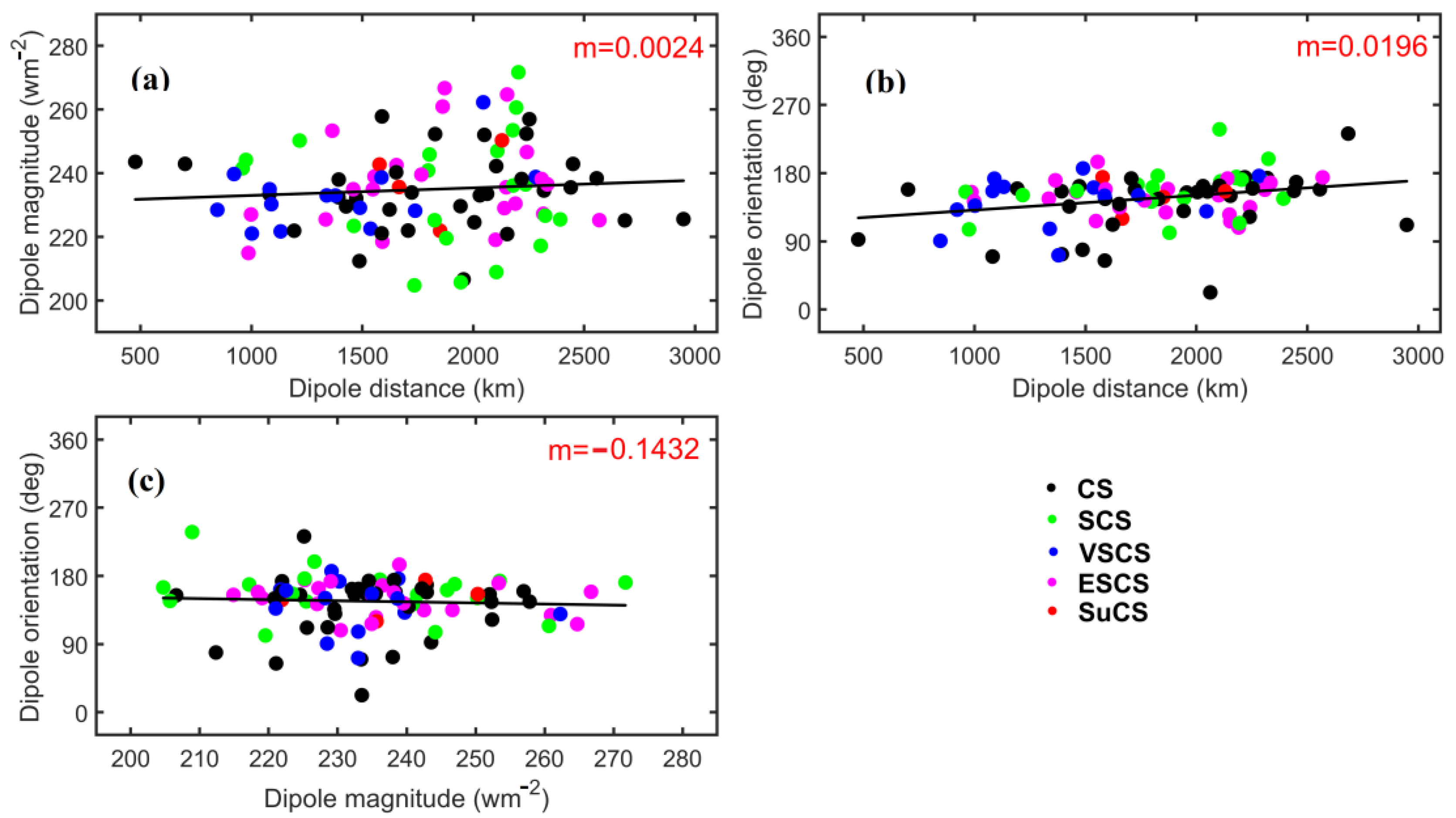
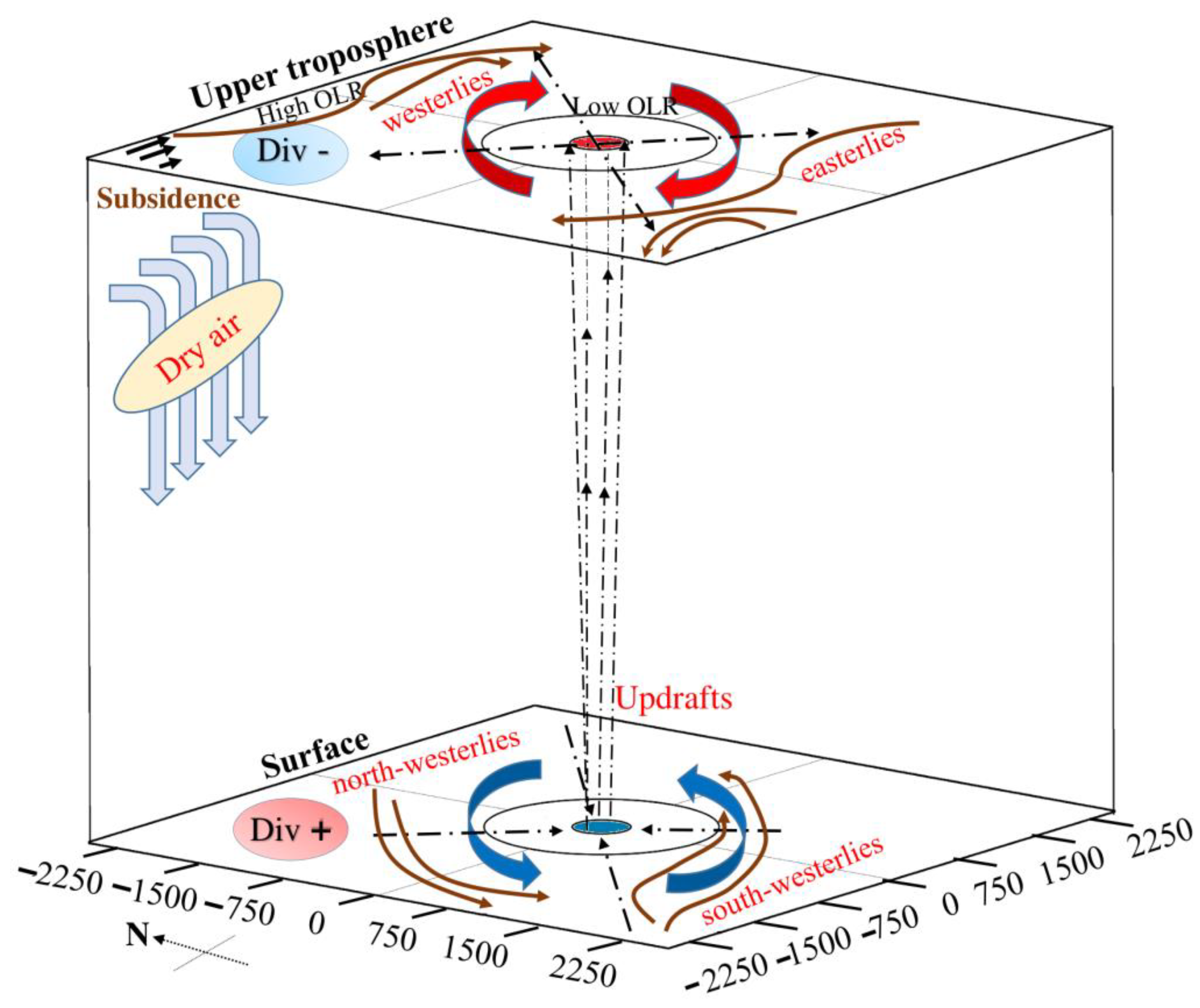
Disclaimer/Publisher’s Note: The statements, opinions and data contained in all publications are solely those of the individual author(s) and contributor(s) and not of MDPI and/or the editor(s). MDPI and/or the editor(s) disclaim responsibility for any injury to people or property resulting from any ideas, methods, instructions or products referred to in the content. |
© 2023 by the authors. Licensee MDPI, Basel, Switzerland. This article is an open access article distributed under the terms and conditions of the Creative Commons Attribution (CC BY) license (https://creativecommons.org/licenses/by/4.0/).
Share and Cite
Gorja, M.M.K.; Gulakaram, V.S.; Vissa, N.K.; Viswanadhapalli, Y.; Tyagi, B. Analysis of Large-Scale Environmental Features during Maximum Intensity of Tropical Cyclones Using Reanalysis Data. Atmosphere 2023, 14, 333. https://doi.org/10.3390/atmos14020333
Gorja MMK, Gulakaram VS, Vissa NK, Viswanadhapalli Y, Tyagi B. Analysis of Large-Scale Environmental Features during Maximum Intensity of Tropical Cyclones Using Reanalysis Data. Atmosphere. 2023; 14(2):333. https://doi.org/10.3390/atmos14020333
Chicago/Turabian StyleGorja, Mohan Murali Krishna, Venkata Sai Gulakaram, Naresh Krishna Vissa, Yesubabu Viswanadhapalli, and Bhishma Tyagi. 2023. "Analysis of Large-Scale Environmental Features during Maximum Intensity of Tropical Cyclones Using Reanalysis Data" Atmosphere 14, no. 2: 333. https://doi.org/10.3390/atmos14020333
APA StyleGorja, M. M. K., Gulakaram, V. S., Vissa, N. K., Viswanadhapalli, Y., & Tyagi, B. (2023). Analysis of Large-Scale Environmental Features during Maximum Intensity of Tropical Cyclones Using Reanalysis Data. Atmosphere, 14(2), 333. https://doi.org/10.3390/atmos14020333








